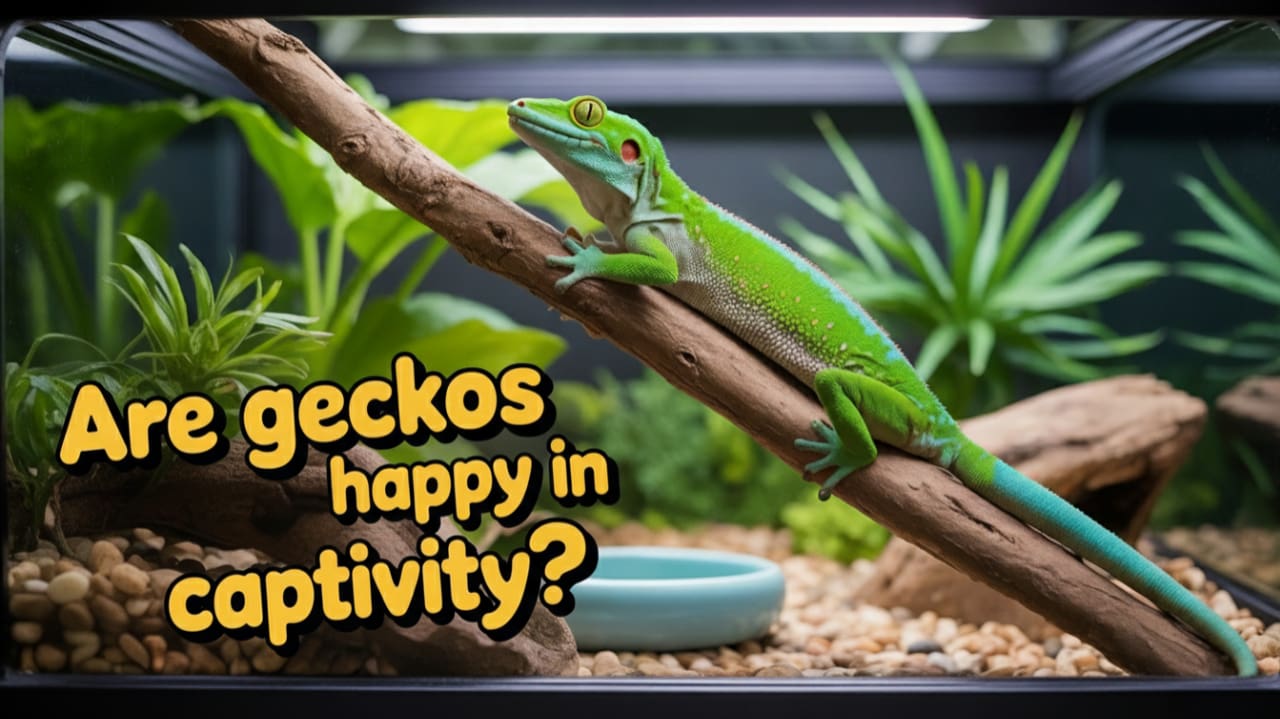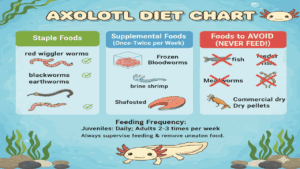Are Geckos Happy in Captivity? Expert Tips on Behavior, Habitat Setup, Enrichment, and Mistakes to Avoid
You can’t keep staring. That calm, well-fed leopard gecko of yours is just minding their own business, looking perfectly content. But sometimes you do wonder. Are geckos happy in captivity?
Well, you should be glad to know that the answer is actually yes. But that is, of course, when you meet their needs.
Exotic pet vets say that happiness in your little reptile isn’t measured by smiles or constant activity. Instead, it’s about how stress-free the environment is. Think proper heat gradients, secure hides, and enrichment that mimics natural behaviors.
Check and see if your setup is adequate. Did you skip a moist hide or choose any unsafe substrates? What about the thermostat and UVB light? An inadequate setup might snowball into some really expensive vet bills that you could avoid.
Unlike wild geckos that spend hours hunting and avoiding predators, your captive little friend relies entirely on you for stimulation. So, make sure that you provide them with varied diets, climbing features, and safe live-feeding opportunities.
You may be surprised what a tiny change, like a $20 upgrade to humidity control, can do for your gecko. Let’s find out what sets genuine comfort apart from survival, shall we?
Beyond the Basics: Your Weekly Gecko Health Check-In
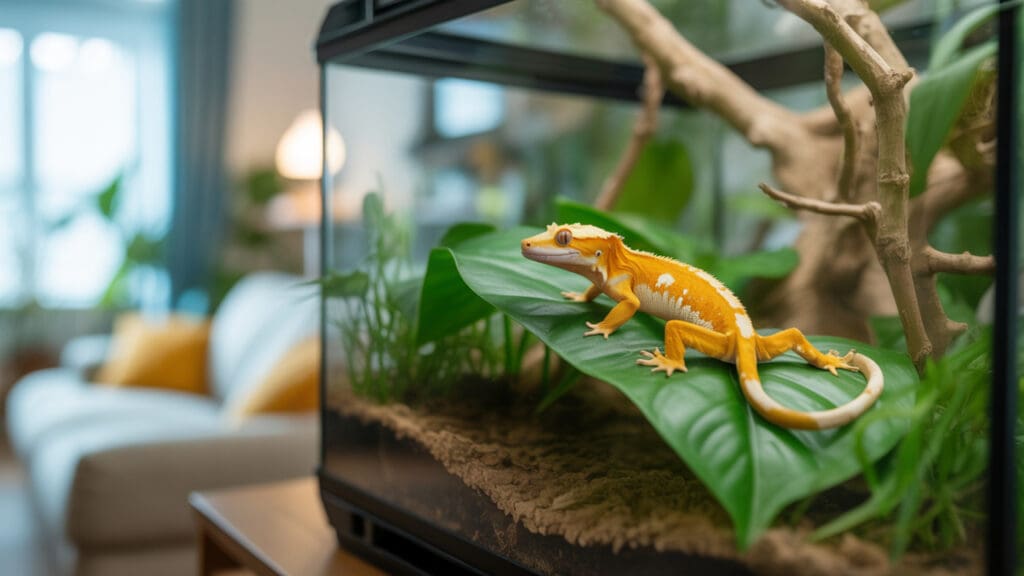
The 5-Minute Weekly Assessment
According to veterinary guidelines from the Association of Reptilian and Amphibian Veterinarians (ARAV), regular health monitoring prevents costly emergency visits. Perform these weekly checks:
Eyes: Clear and bright with no discharge, swelling, or retained shed around the lids. Sunken or stuck-shut eyes indicate dehydration or infection requiring immediate veterinary attention.
Tail: Should be plump and firm, not mushy or shriveled. The tail stores fat reserves, making it an excellent indicator of your gecko’s overall health.
Weight Tracking: Use a digital gram scale weekly, especially for juveniles who should gain approximately 1 gram per week during their first 8 months. Sudden weight loss may indicate illness, parasites, or inadequate nutrition.
Skin Condition: Check for stuck shed, especially around toes, where retained skin can cut off circulation. Post-shed skin should appear bright and healthy.
Appetite and Behavior: Note feeding response times and exploration patterns. A healthy gecko should respond to movement and show curiosity about their environment.
The Monthly Assessments
LafeberVet recommends comprehensive monthly assessments:
Complete Enclosure Cleaning: Disinfect the entire habitat using reptile-safe cleaners or a 3% bleach solution, allowing 10 minutes contact time for proper disinfection.
Equipment Calibration: Check thermostat probe accuracy using an infrared thermometer. Temperature fluctuations of more than 3-4 degrees can stress your gecko.
Fecal Assessment: Healthy gecko waste includes clear liquid urine, chalky white urate, and brown fecal matter. Blood, unusual colors, or consistency changes warrant veterinary consultation.
Do Geckos Have Feelings? Understanding Gecko Happiness in Captivity
Perhaps it’s a question a friend has thrown at you. Or maybe it’s just a random thought. But it should’ve crossed your mind if you own one of these reptiles. Are geckos happy in captivity? What makes a gecko happy? How can you even tell if they are happy?
Your gecko certainly can’t wag their tail or smile in contentment. But you should be able to see some behavioral cues that tell you that they are comfortable, secure, and healthy.
First, understand that “happiness” for your little reptile companion means stress-free living. You can equate that to a habitat that meets their physical, environmental, and behavioral needs. If your gecko is happy, they’ll be able to move around easily to explore their enclosure. They’ll also eat consistently and find a basking or hiding spot naturally.
Now, don’t assume that your gecko is content just because they are alive and eating. Your gecko might just be tolerating the suboptimal conditions. And this could go on for months before you see any signs. That’s why you should do a vet-recommended habitat check every few months so that you know what adjustments you need to make.
You may need to invest a little more initially in a proper terrarium, heating elements, hides, and UVB lighting. But this upfront cost can help decrease future health issues in your reptile friend. Remember, it’s cheaper to prevent than to treat.
Are Geckos Happy in Captivity? Myths and Misconceptions About Happy Leopard Geckos
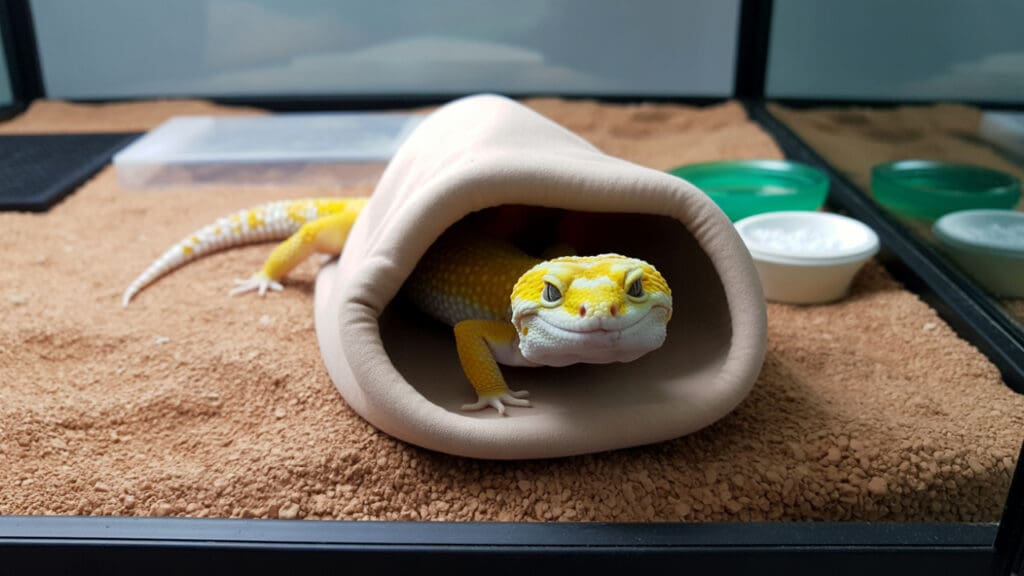
Let’s take a look at leopard geckos specifically. They are very much one of the most popular gecko pets (and probably the species you own), but the myths surrounding them are just as popular. So, let’s take a look at some of these misconceptions.
One of the most common myths out there is that your leopard gecko’s “smile” (you’ve at least seen it on the Internet) tells you that they are happy. Sadly, that curved mouth shape is just part of their anatomy. So, don’t go thinking that your friend is giving you an emotional grin.
Another myth is that your gecko will be happy in any enclosure as long as they are fed regularly. Well, food is definitely important to keep your leopard gecko happy (comfortable). But you’ll need to pair that with proper temperature gradients, humidity, secure hides, and enrichment opportunities.
Remember, decorative items aren’t as important as functional habitat upgrades. What your little pal needs is a safe substrate, correct heat placement, and areas for privacy. So, make sure you invest in the right resources for your gecko’s comfort rather than for your human eye.
The next misconception is that your reptile friend doesn’t need UVB lighting because leopard geckos are crepuscular. No. Some may be able to survive without it. But they need moderate UVB exposure to help improve calcium metabolism and overall health.
Are Geckos Happy in Captivity? Behavioral Signs of a Happy vs. Stressed Gecko
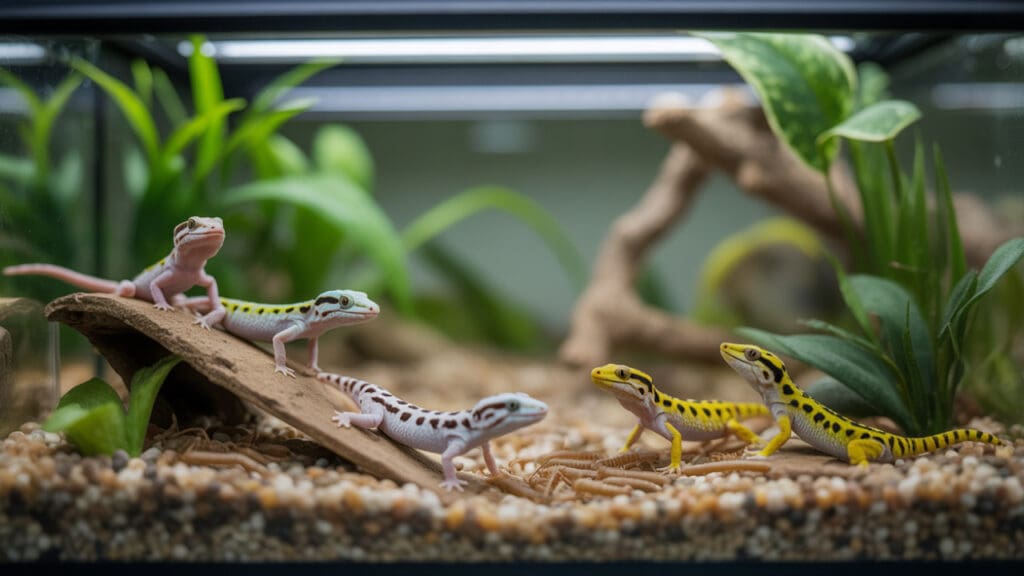
You’re not sure if your gecko is thriving or silently struggling? Don’t fret. You can often tell from observing their behavior. Watch out for some of the following cues.
Your happy leopard gecko (or any other species) will explore their environment, moving about in the available space in good spirits. You’ll also find that they respond to feeding times. And they should show curiosity when there’s movement or changes in the enclosure. Besides that, you will likely see them basking in warm spots, resting calmly in hides, or even flicking their tongue to check out their surroundings.
A stressed-out gecko, on the other hand, will show you quite the opposite signs. They are likely to hide excessively, and this can be a persistent behavior. You might also see your gecko friend glass surfing or waving their tail in agitation. They are also likely to lose their appetite, show some erratic movements, or even unusual aggression. These are all warning signs that the habitat is off in some ways.
Don’t assume that your companion’s stress will just go away on its own. Exotic pet experts say that even subtle signs could be an early warning of illness. So, don’t wait till the signs turn into serious health issues. That’ll cost you more than just a $20 equipment upgrade.
Experts recommend that we maintain a habit journal for our gecko. You should record your little guy’s feeding times and shedding frequency. Of course, take note of their behavior as well. If you see anything that deviates from the usual patterns, you know something’s off.
Are Geckos Happy in Captivity? Creating the Ideal Leopard Gecko Habitat in Captivity
Your leopard gecko in captivity can certainly live a long, healthy life. But of course, you’ll need to really take care of their environment. Keep this in mind. You want to make sure the place mimics their natural habitat.
At its very core, you want to provide your gecko with three essential things. These include proper heat gradients, safe hiding spaces, and the correct substrate.
First, vets recommend that we keep two sides in the enclosure, one warmer, one cooler. The warmer side should be kept between 88–92°F. It’ll be a good temperature for helping your gecko with digestion. The cooler side, on the other hand, should be around 75°F. This half is meant to prevent your little one from overheating. You should be able to find a reliable thermostat for under $30.
Now, you also want the hides to be cozy and help your gecko relieve stress. Similarly, you need one warm hide and a cool one. Additionally, you should have a moist hide that can help your little one with their shedding process. Just a few dollars’ worth of sphagnum moss and a plastic container will do. Don’t underestimate the importance of a moist hide. It can prevent shedding complications, which can lead to a vet visit.
Then, there’s lighting. Your gecko might be crepuscular, but it needs some amount of UVB lighting, about 5-6%. This can help improve calcium metabolism and reduce the risk of metabolic bone disease. Think of this as an investment for your pet’s skeletal health.
Are Geckos Happy in Captivity? Comparing Wild vs. Captive Leopard Gecko Behavior
Now, your leopard gecko in captivity isn’t likely to behave exactly like their wild counterparts. Let’s take a good look at how they differ.
You may have heard that wild leopard geckos are solitary. They are very active at dawn and dusk. And they spend much of their time foraging, hunting insects, and avoiding predators. Their routines are based on their survival instincts. So, these wild ones are always moving, always scanning their surroundings, and responding to environmental changes.
Your gecko, however, adapts their survival instincts to match their captive status. They learn what to expect in the environment that you manage. It’s about predictability. Your little one, now, does not need to hunt. So, they may be calmer, make more exploratory movements, and spend more time basking or resting in hides. This benefits their health.
That said, this lack of predator stress can also mean less physical stimulation. So, you’ll need to provide your gecko with enough enrichment. Remember, if your gecko is inactive, they may be signalling stress, illness, or environmental deficiencies. Exotic pet vets say that we should monitor our little one’s feeding behavior, shedding frequency, and movement.
Are Geckos Happy in Captivity? Common Mistakes That Can Make Geckos Unhappy in Captivity
Even if you love your little reptile friend so much, there’s no guarantee you won’t make any mistakes at all. So, learn to avoid them to keep your leopard gecko happy.
Let’s talk about substrates first. You may find loose sand sold in many pet stores. However, they may not be the ideal substrate for your gecko. The sand can be easily ingested. And when your little one eats too much of it, it can cause impaction. Try using a safer option, like reptile carpet, tile, or packet soil mix. These may cost a bit more upfront, but they can prevent expensive vet procedures later.
Next, you should not overlook proper heat gradients. Make sure that you’ve got a warm zone and a cool one so that your gecko can live comfortably. Your little companion can’t regulate their body temperature. So, if you don’t provide the right setup, they will likely experience poor digestion and stress.
The other thing is humidity. Make sure that you have a moist hide for your gecko. This can help prevent retained shed, which can lead to rather painful complications for your little friend.
The way you should handle our gecko is also another misunderstood area. Overhandling your gecko can stress them out, and this can become chronic. You may be enthusiastic about having gotten a new pet. But stay calm, schedule sessions for handling your gecko, and let them retreat to their hide afterward. This can help build trust between you.
A Step-by-Step Gecko Bonding Guide
Phase 1: The Settling-In Period (Weeks 1-2)
ARAV guidelines emphasize that newly acquired geckos need adjustment time without handling:
No Direct Contact: Allow your gecko to acclimate to new sounds, smells, and routines. Sit near the enclosure daily for 10-15 minutes, speaking softly.
Feeding Schedule: Establish consistent feeding times to build positive associations with your presence.
Phase 2: The Hand-in-Habitat Approach (Week 3)
Passive Introduction: Place your motionless hand, palm up, inside the enclosure for 5-10 minutes daily. This allows scent familiarization without pressure.
Temperature Consideration: Ensure your hand is warm (room temperature or slightly above) as cold hands can startle reptiles.
Phase 3: The Gradual Lift-Off (Week 4+)
Progressive Elevation: Once your gecko willingly walks onto your hand, slowly lift them 1-2 inches inside the enclosure. Gradually increase height and duration over several sessions.
Success Indicators: According to veterinary behaviorists, positive signs include voluntary hand contact, calm breathing, and lack of escape behaviors.
Session Limits: Keep handling sessions under 15 minutes to prevent stress accumulation. Adult geckos over 6 inches can typically tolerate longer sessions.
Are Geckos Happy in Captivity? Long-Term Welfare
If you want to keep your gecko happy for a long time, make sure you build a consistent routine. And it should benefit their physical health and provide mental stimulation. Your leopard gecko, particularly, can live up to 20-25+ years if you take care of them well.
As mentioned, you’ll need to make sure to provide a stable environmental condition. So, keep in mind your gecko’s needs in terms of the temperatures, feeding schedules, and humidity levels. With quality heating equipment, timers, and reliable thermometers, you should be looking at around $50-$100 upfront. But these should help your gecko feel comfortable and stay healthy.
Next, make sure you provide your gecko with a proper diet. Your little one likes a varied insect diet. The insects should be gut-loaded, and you can even dust them with calcium and vitamin D3 supplements. Remember not to rely on just one type of insect. It can lead to nutritional deficiency over time.
Enrichment is important for your gecko’s mental well-being. Try introducing climbing branches and textured surfaces. You can also do a feeding challenge, like letting them hunt for live insects. This can provide significant stimulation and encourage natural activity patterns. And your gecko will be less likely to be bored or stressed out.
Mental Stimulation: How to Beat Captive Boredom
The Decor Rotation Strategy
Research shows that environmental changes significantly increase gecko activity levels. Implement a monthly rotation system:
Basic Rotation: Maintain a collection of 4-6 additional decor items (cork rounds, smooth stones, artificial plants). Swap 1-2 items monthly to create novel exploration opportunities.
Seasonal Themes: Introduce seasonal elements like dried leaves in autumn or smooth river stones in summer. This mimics natural environmental changes and maintains engagement.
Novel Feeding Strategies
Studies demonstrate that enriched feeding increases behavioral diversity and natural hunting patterns:
The Hunter’s Challenge: Use feeding balls or puzzle feeders that require manipulation to access insects. This extends feeding time from seconds to minutes, providing substantial mental stimulation.
Scatter Feeding: Distribute insects throughout the enclosure rather than bowl-feeding. Research shows this increases exploration behavior by up to 200%.
Live Plant Integration: Safe gecko plants like pothos or spider plants provide hiding spots for insects, encouraging natural foraging behaviors.
Bioactive Setup: The 2025 Gold Standard
According to current herpetological research, bioactive systems provide optimal enrichment:
Clean-Up Crew Benefits: Springtails and isopods (like Dairy Cow isopods) create a self-cleaning ecosystem while providing occasional snacks for your gecko.
Microhabitat Diversity: Different substrate depths and moisture gradients allow natural digging and exploring behaviors.
Setup Requirements: A drainage layer with clay balls, bioactive soil mix with organic components, and live plants create a naturalistic environment requiring minimal maintenance.
FAQs About Gecko Happiness in Captivity
If you’re a gecko owner or about to be one, it’s possible that you still have questions about your little friend’s welfare that go beyond the basics of feeding and cleaning. Let’s check out 10 of the most frequently asked questions regarding this topic to help you provide the best possible care to your gecko.
1. How do I know if my gecko is happy?
Your gecko is most likely happy if they are eating steadily. Their movements should be calm. And they should also be exploring their enclosure without signs of fear or stress.
2. Do geckos get attached to owners?
First, you should note that they may not bond with you like mammals do. However, geckos can become accustomed to your presence and handling. And you should be able to see it in the way that they are less stressed over time.
3. Are geckos happy as pets?
Yes. If you provide them with proper care, enrichment, and habitat conditions, your gecko can live a comfortable and stress-free life. This is what it means for them to be happy.
4. Do geckos do well in captivity?
Most species adapt well to captivity. That said, you will need to provide them with the correct temperatures, humidity, and enrichment opportunities.
5. How long can a gecko live in captivity?
Assuming that you are excellent at taking care of them, many gecko species (like the leopard gecko) can live 10–20 years in your home.
6. What is the best habitat setup for a leopard gecko in captivity?
A secure enclosure should include a warm and cool side. You should also consider getting a safe substrate and providing hiding spots. Also, set up a moist hide for your gecko to support their health and comfort.
7. Can geckos feel emotions like happiness?
They don’t feel emotions exactly as we humans do. However, they do show behaviors that are linked to comfort, safety, and reduced stress.
8. Why is environmental enrichment important for captive geckos?
Enrichment encourages natural behaviors and promotes exercise. It helps prevent your gecko from getting bored and stressed out.
9. Do leopard geckos behave differently in the wild vs. in captivity?
Yes. You should know that wild geckos spend more time hunting and avoiding predators. Your captive geckos, on the other hand, rely on human-provided care.
10. What are signs of stress in a gecko?
Beware of warning signs, including loss of appetite, excessive hiding, color changes, or restless movements like glass surfing.
Are Geckos Happy in Captivity? How to Ensure They Thrive
Are you ready to take the first step in keeping your gecko happy? Remember, the key is to provide consistent and attentive care.
You’ll want to balance proper heat and humidity to let your little one live comfortably. Also, make sure that the habitat design is safe and enriching. Never forget a diet that meets their nutritional needs, too.
You should take extra care to avoid pitfalls, like using unsafe substrates or neglecting enrichment. These could save you quite a bit of money in the long run. In short, focus on preventing rather than treating a health issue.
With the right environment and habit, we’re sure that you are capable of keeping your gecko thriving and healthy. Apply these tips today, and observe the reward for years to come.
Have you noticed anything that makes your gecko happier? Share your tips below with the other pet parents! We’d love to hear from you.

